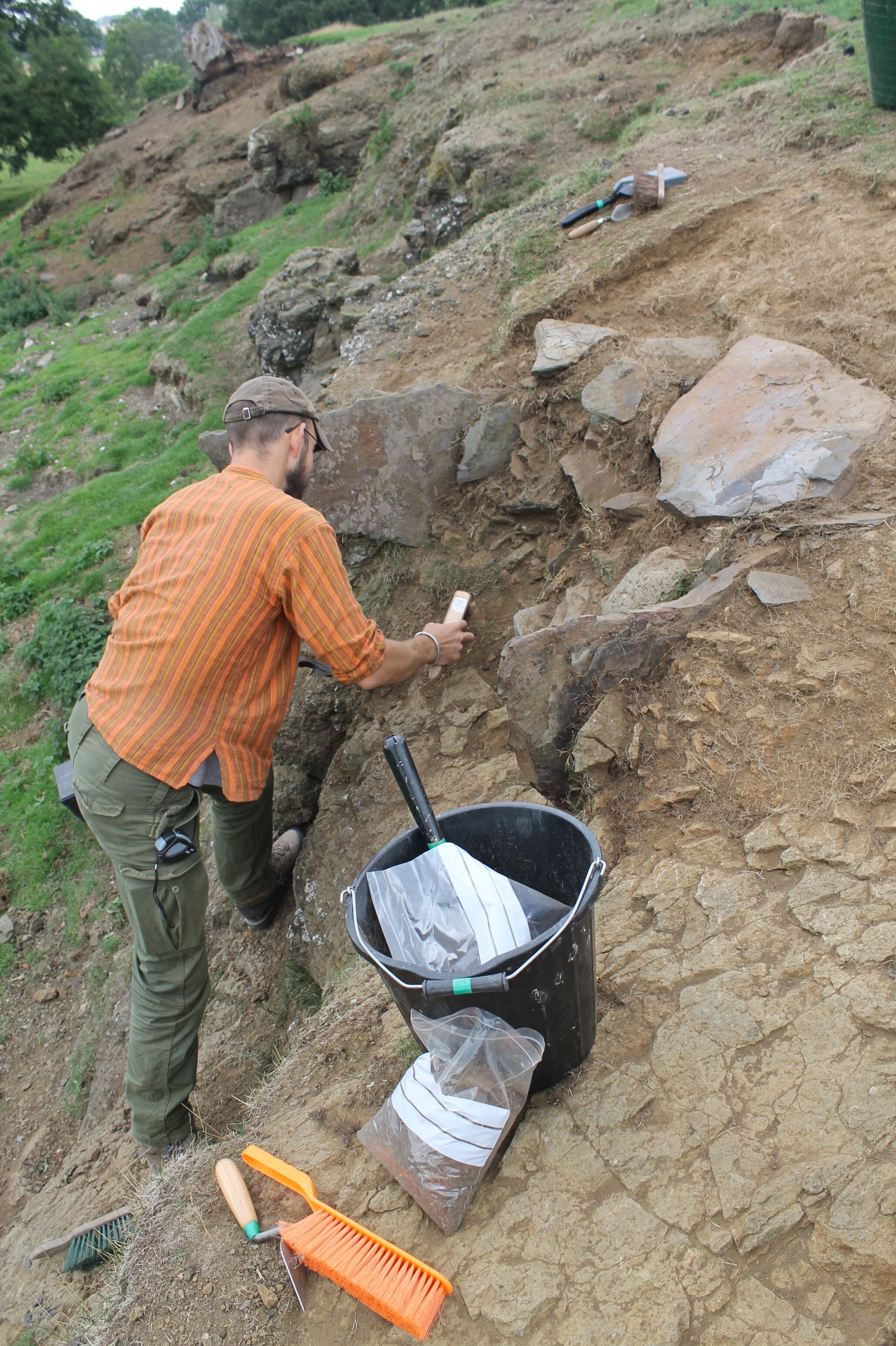A Brooch from a Cist Burial at the House of the Binns, West Lothian
In August 2013, human bone was found eroding from a small bedrock quarry face at the House of the Binns, West Lothian, during routine monitoring by National Trust for Scotland (NTS) archaeologists. Upon excavation, a stone cist was identified. It was found to contain the remains of two adult males. The first was aged between 30 and 50 years old; these remains had clearly been disturbed by the placement of a second individual, a young adult, in the cist. Radiocarbon dating showed that the burials date to the first centuries BC/AD. The younger man was wearing a penannular brooch pinned at his left shoulder, and traces of textile were found adhering to the brooch - an extremely rare discovery. AOC was commissioned to undertake analysis of the brooch, and conservation of the brooch and its associated textile. The images below show Dr Daniel Rhodes, one of NTS’s archaeologists, carefully excavating the cist.
The Brooch
The simple, undecorated, penannular brooch is made of iron and measures between 38mm and 42mm in diameter. The form of the brooch, with small, plain, rounded knobs on the terminals of the hoop and a slightly arched pin, was a style in use for a long period, perhaps from the 1st century BC to the 3rd century AD. It has been suggested that these brooches may have been popular in Scotland only after the arrival of the Romans in the first century AD. However, the radiocarbon dates obtained from the human remains with which the brooch was associated place the brooch’s use within the earlier half of this date range, suggesting that they were in fact in use in pre-Roman Iron Age Scotland.
The brooch following conservation, with mineralised textile visible at the left hand side
This type of brooch is very rare in Scotland, with only a handful of examples known. Grave goods are rarely found in association with Iron Age burials but where they do exist, dress accessories and ornaments are the most common category. Within these, penannular brooches are the most common type of dress fastener.
X-ray of the brooch showing bone attached to corrosion deposits
The position of the brooch, on the left shoulder, suggests that it was used to fasten a garment, probably a cloak, at the neck or shoulder. A bone attached to the brooch/corrosion deposits (visible in the X-ray above) was identified as a rib bone, which clearly demonstrates its position in the cist. The brooch is not a perfect circle and it is possible that this is the result of distortion due to use, which would indicate that such items were not reserved for use only in a burial context but were worn in life too. No trace of a dress fastener was found associated with the older individual. This might indicate a distinction in the style of costume of the two men: the older individual may have been wearing garments that did not require a metal dress fastener, or the fastener used may have been made of a different material which did not survive.
Conservation of the Brooch
On arrival at AOC’s lab, the form of the brooch was obscured by iron corrosion which had formed around the brooch surfaces encasing pieces of mineralised textile, and both were very fragile. The brooch was X-rayed to establish its form and to assist our Conservator’s in determining their strategy of how best to clean and stabilise the metal brooch, whist also preserving what remained of the textile. This conservation work was essential, not only to preserve the brooch and the textile for long-term curation but also to reveal details of the object and the fabric to enable specialist analysis.
The textile is mineralised, meaning that its structure has been replaced by the iron corrosion deposits, and it is this process has ensured its preservation. This is remarkable, and enabled the mineralised textile to be studied by a textile specialist, and identified as wool.
After initial stabilisation and examination by a textile specialist, the brooch underwent further treatment but the remaining textile was left in place revealing the details of its fine weave and the way it is gathered around the brooch pin.
Find Out More
A paper co-authored by NTS’s Dr Daniel Rhodes with AOC’s Dawn McLaren and others is published in the Proceedings of the Society of Antiquaries of Scotland, volume 146 (2016), pp103–112. You can download a copy here.




